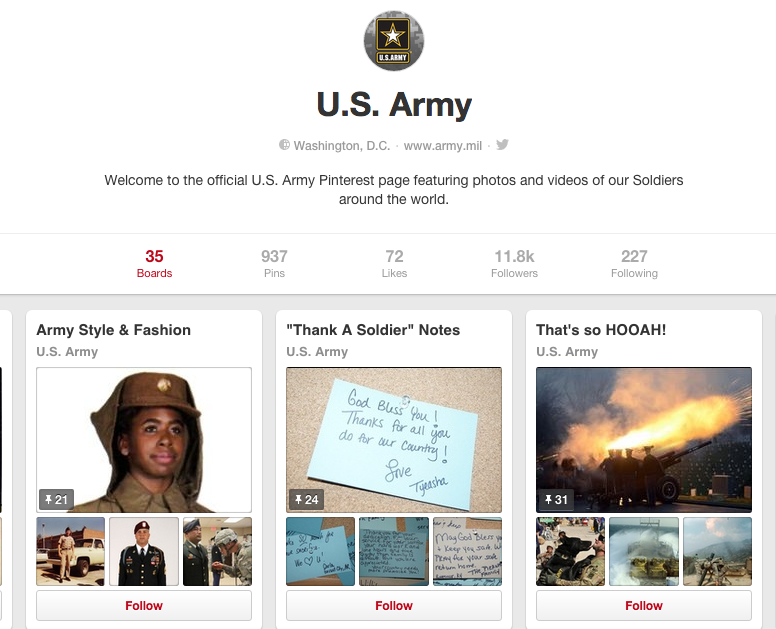Over the past few weeks, I’ve been talking about how federal agencies use social media platforms, and more specifically, Facebook, Instagram, Twitter, and YouTube. There are a ton of other sites out there that speak to various groups of people or have particular uses. Because it’s important for government to reach its audience in the way (or ways) it most likes to be communicated with, this week, I’m rounding up my social media tour with some of the other sites in use by federal agencies and what tips you can take from them. (Please note that this certainly is not an exhaustive list of all of the agencies, departments, and offices that have a presence on social media sites, other than the big four I’ve already profiled. That said, if your agency is on a site I haven’t covered, please share with us in the comments!).
Pinterest: I always knew the White House was on Pinterest (sharing photos from the West Wing and stories that come out of their press office, among other things), but I was curious what appeal other agencies might find. I’m including some federal Pinterest pages below, but my key takeaway here is that while the platform is often for collecting recipes and craft ideas (at least for me), it’s an amazing place for federal agencies to share tips relevant to their mission (like the Department of Energy does) with an audience that might not be regularly checking another social media site.
- The National Archives pins links from its own website in various historical categories (like political cartoons)
- The US Mint pins pictures of its coin collection categories
- HHS has a collection of pins from various federal agencies all aimed at keeping Americans healthy (and the same goes for CDC)
- The Army, Navy, and Marines have a ton of pins that focus on different topics, including life in the military, information on what to put in care packages, and stories about those who serve
- SSA has a collection of presidential quotes about the Social Security program, pins related how to apply, and pins about what services are offered
LinkedIn is being used by a number of federal agencies, including the EIA, CDC, FEMA, CBP, Fannie Mae, Freddie Mac, GAO, and the FAA. Most of the LinkedIn pages I looked at contain a lot of reposts of information that was already distributed on the agency website, and they seemed like Facebook pages for professionals. And frankly, that’s great. There are many people who prefer to use Facebook for their personal lives and leave business to LinkedIn, so there is really no harm in repeating the message, so long as it is still relevant to your LinkedIn audience. There are some other interesting uses. For example, CBP primarily uses its profile for posting available jobs, while Fannie Mae generates discussion and answers questions (typically about mortgages).
Google+ is a pretty popular social media site for the feds. Similar to other platforms, a majority of the agencies using Google+ are focused on reposts from website content. The difference here are the “hangouts” that a number of agencies host to allow their audiences access to the agency. Of course, there are a number of issues when you hold a live discussion, but it’s fantastic that these organizations are using social media in a different way to share useful information and answer questions or concerns. Some of the feds on Google+ include:
- Minority Business Development Agency
- National Geospatial Intelligence Agency
- US Army
- US Navy
- National Guard
- CDC
- VBA
There are also a number of agencies on Tumblr. The Department of State uses its page to display pictures, quotes, and videos (mainly from Secretary Kerry’s travels). The Office of the Director of National Intelligence uses its page to share official statements, documents, fact sheets, some videos, and the text of speeches and interviews. The BLM Tumblr page is a bit more blog-like, in that it features photos with lengthier posts. The same goes for the Bureau of Reclamation and U.S. Fish and Wildlife. I think the blog format, in particular, is a great use of the site for sharing information. A number of federal websites already have blogs built into them, but if you aren’t someone who’s already going to the agency website, you aren’t going to see those blog posts. On Tumblr, you’re again communicating with audiences in the way in which they prefer.
NASA, SBA, and the EPA are all on Foursquare sharing location-specific tips and info that relate to their organizations. EPA, for example, has a ton of posts about how federal funds from the agency are being used at various colleges and universities. While the audience is small, it’s a great way for agencies to broadcast the work they are doing in various locations with users.
I admittedly felt a bit out of touch while working on this post when I noticed that a handful of agencies were on a social media site I had never even heard of. Storify is currently being used by the White House, Department of Education, National Archives, Defense Logistics Agency and Department of Energy. None of the pages have many followers. The White House had the most at just over 5,400. For those (like me) who don’t know what Storify is, it essentially allows users to create a “story” or timeline by integrating posts from Twitter, Facebook, Flickr and Instagram. The National Archives, for example, has roundups of Twitter chats interspersed with Flickr and Instagram pictures of the topic in question. The White House does the same, and also provides roundups of the president’s travels abroad and goings on at the White House. Because this site is primarily a roundup of already produced social media content, I think the key takeaway is that having a packaged “story” about a specific project your agency is working on, event you’re participating in, etc., is great, especially for those in your audience who might not be chronic news readers or might not be visiting your website. Here, they get the full picture, in a format they like, in more than 140 characters or one picture.
I found a smattering of feds on SlideShare (LinkedIn’s presentation sharing platform) and UStream, and one on Scribd (the Office of the Director of National Intelligence). Of these pages, the only ones that seemed to be frequently updated were the NASA and Consumer Product Safety Commission SlideShare pages, which included tons of presentations for both internal and external audiences (NASA, for example, has a presentation aimed at its labs for conducting Google+ hangouts). Given that all of these sites had small followings, it’s hard to say what the key takeaways might be. If these sites are mainly used to repost already distributed agency information, it might be worth the time, but I don’t know that creating new content for these sites would truly be worth it. Please feel free to disagree in the comments and share your own experience!





Leave a Reply
You must be logged in to post a comment.